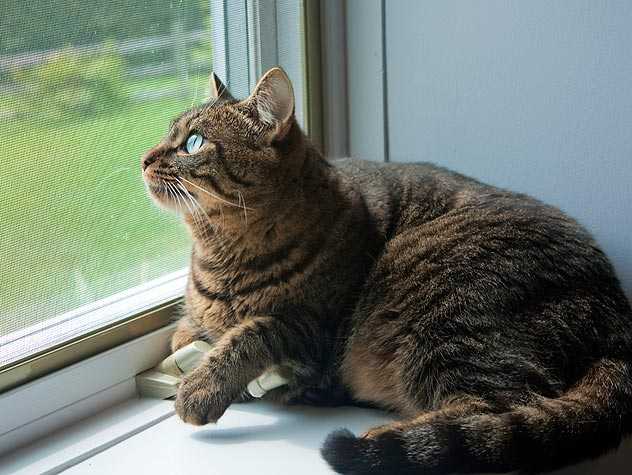Transitioning an Outdoor Cat to Indoors

Autumn is slowly making way for Old Man Winter, and your concern is steadily growing for the stray cat who settled into your backyard last summer. Homeless Hildegarde has been enjoying your fresh-air hospitality under the deck all season, but with cold weather approaching, there's no better time to introduce her to the pleasures of indoor living. Luckily, bringing a friendly stray in from the cold or keeping an indoor/outdoor feline entirely inside is not as difficult as one might think. All it takes is some environmental enrichment and a bit of training.
Litter box training is the biggest concern for most people. If the cat was ever box trained, she will likely fall right back into the habit. For the former indoor/outdoor cat, a two-box system filled with fine-grain, clumping litter works best. Place one where you want the litter box to permanently reside, and put the transitional box at the door the cat once used to exit the house. When she finds that she can't get outside to the topsoil, she will use the box by the door. After that habit is established, slowly move the transitional box closer to the permanent setup. Once the boxes are side by side you can remove one of them.
For the cat who has never been litter box trained, a confinement method is usually necessary. Set the cat up in a cattery cage or a large dog crate complete with litter box, resting space, food, water and toys. When the cat is consistently using her litter box, she can be moved to a small room, like a bathroom or galley kitchen. After she gets the hang of that, you can increase her space yet again. If she has a lapse, return to the last space the cat kept clean. Don't forget to visit her often and release her for supervised exercise, grooming and affection during the confinement period. Also, once she has earned the free run of your home, make sure she isn't tempted to use your potted plants as a litter box. Cover soil with aluminum foil, or pack glass pebbles or marbles around the plant.
Enhancing Your Cat's Habitat
When litter box training is complete, you can begin to enrich your cat's new environment. Since her days will no longer be spent searching for her supper, she'll need something else to while away the hours. Window perches allow your indoor cat to keep an eye on the backyard bird population while safely basking in the sun. An indoor planter containing feline favorites such as catnip and wheat grass enables your cat to nosh on cat-safe greenery. Toys are a must for these reformed hunters; interactive playthings sporting feathers are especially enticing. Just remember to rotate toys every week or two to keep your feline's interest piqued.
To safeguard furniture from a cat who's used to scratching wherever she pleases, offer several kinds of scratching posts and determine her pleasure. Look for posts that are sturdy enough to climb. Cat tree furniture, which usually includes several resting platforms atop natural tree trunks or posts wrapped in sisal, is a good bet. Placement near a sunny window or patio door guarantees enjoyment. In addition, cardboard scratch pads embedded with catnip are inexpensive and can be scattered throughout your home.
Overcoming the Lure of the Outdoors
Although indoor living has many perks, the call of the wild can be intense for some cats. Given the opportunity, these cats will attempt to dash for freedom whenever a window is opened or a door is left ajar. Make sure screens fit snugly in windows and cannot be dislodged by a persistent cat. Dissuade door-dashing by drawing your cat away from doorways before entering and departing your home. Roll a toy or toss a treat across the room to focus kitty's attention away from the door. If there are children in your home who come and go frequently, stage practice runs with your cat. Leave the door ajar; if she begins to saunter out of it, startle her with a blast of canned air or a spritz of water from the outside. If the outdoors proves inhospitable, it's likely to dampen her ardor for adventuring. A backyard cat enclosure can fulfill the fresh air needs of a hardcore outdoor lover while keeping the cat and nature safe from one another.
By the time winter sets in, you'll be able to sit back and enjoy watching the first snowflakes fly. Hildegarde will be napping on the hearth, safe and warm and there to stay.